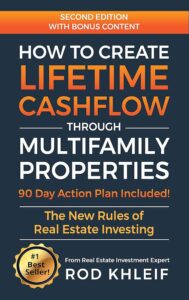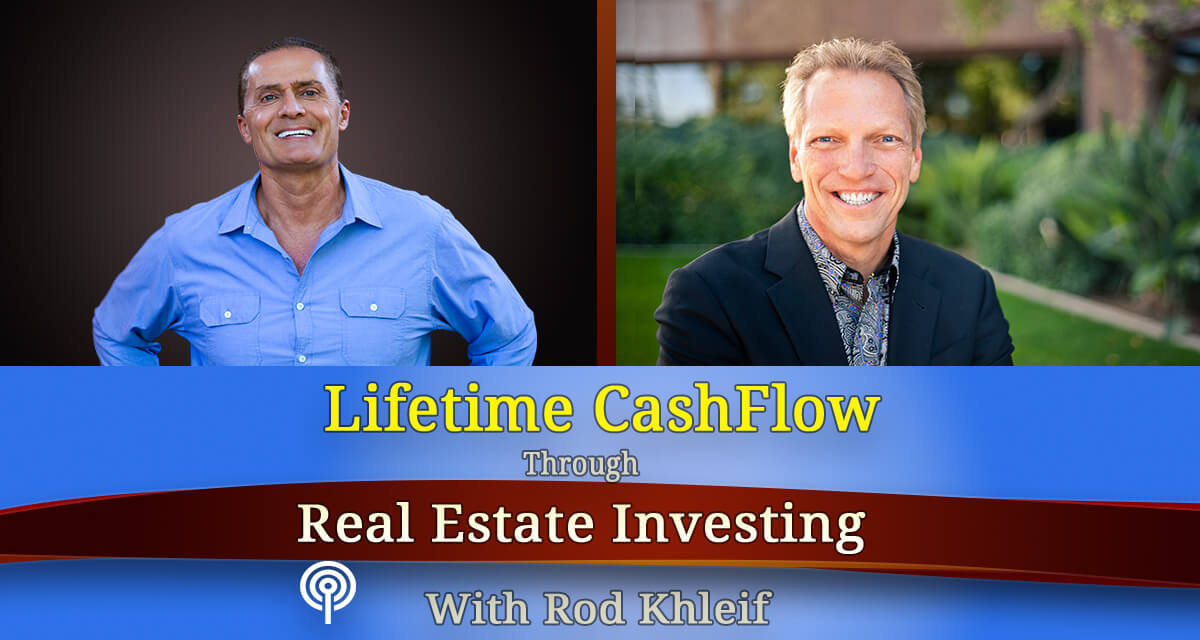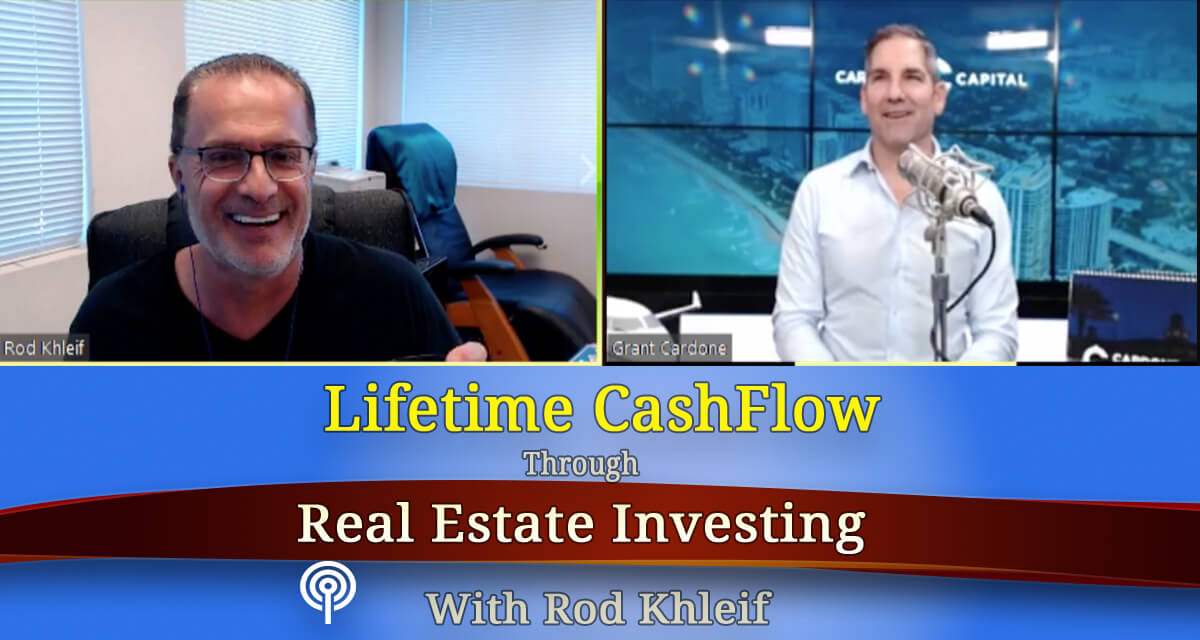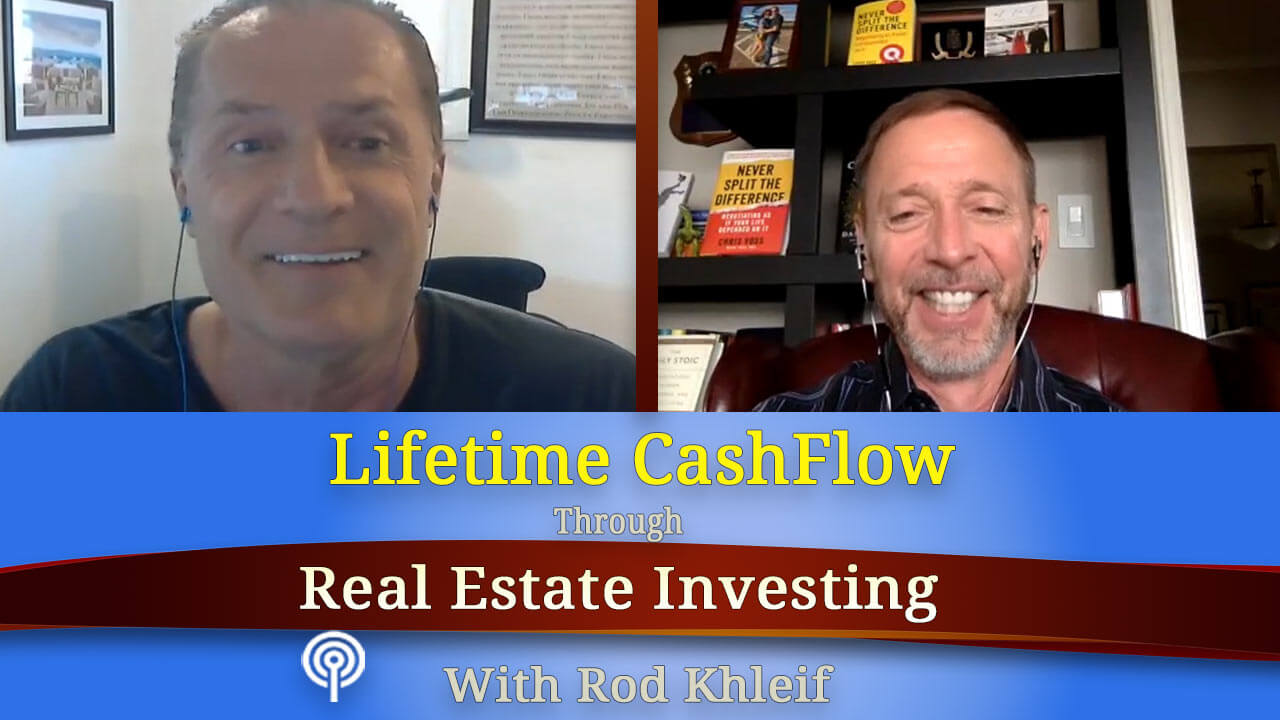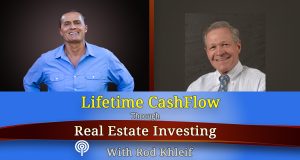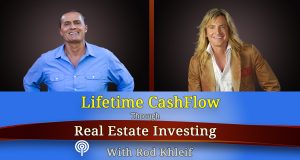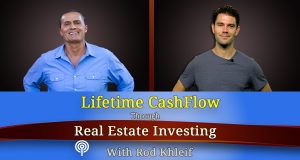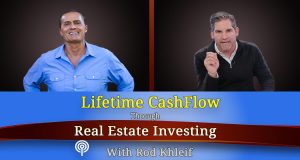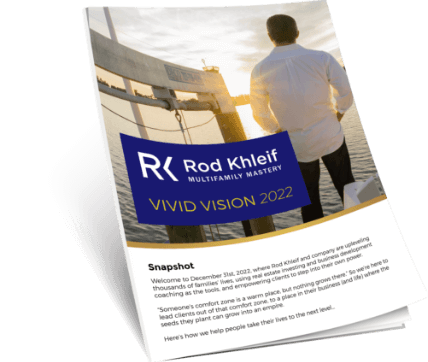Ep #524 – Why going bigger is better with multifamily real estate
With more than 12 years of real estate and construction experience, Jorge Abreu is second to none when it comes to evaluating & renovating properties. Jorge currently has $125M of assets under management totaling 1720 units.
Here’s some of what we talked about:
- Creating a JOB for yourself?
- The benefits of passive income
- 70+ units – can support full time staff
- Steps to take when improving an asset
- Due diligence process
- The power of a Vision Board
- Current economic outlook
Book Recommendations:
Traction by Gino Wickman
Three Feet from the Goal by Lechter & Reid
To find out more about our guest:
Full Transcript Below
Rod: Welcome to another edition of “How to Build a Lifetime Cash Flow to Real Estate Investing”. I’m Rod Khleif and I’m thrilled that you’re here. And I’m super excited about today’s interview with my friend, Jorge Abreu. Now, Jorge and I have known each other a while. He’s been to my boot camp. He’s a hitter. And we had a lot of fun because we were both at a mastermind in Jamaica recently and really got to know each other a little better. Now, Jorge, if you don’t know him, he’s in over 1700 doors as a GP and he’s a LP and a thousand doors now. He’s the CEO of Elevate Commercial Investment Group and he’s also got a construction company called JNT Construction. In fact, we had them help us with an asset that we’ve got under contract right now in Dallas called Cottonwood, 270 units. He helped us with some of the due diligence there. And so, really excited to have him on the show. Welcome, brother.
Jorge: Thank you man, thank you. I’m excited as well.
Rod: So, let’s have some fun today. So, you know, let’s start the way we always do Jorge and just have you tell my listeners a little bit about your background, how you got in the business? I know there’s a big construction component but let’s educate anyone that has not heard you’ve been interviewed before.
Jorge: Sure. So, you know, I’m originally from South Florida. I know you’re over in Florida as well.
Rod: Right.
Jorge: And I went and started getting my Electrical Engineering degree. Throughout those five years of getting my degree, I kind of realized that I didn’t really want to go down that path of being an engineer and I really wanted to open up my own company. I wasn’t sure what at that time. But started doing some research on successful individuals and it kind of kept coming back to real estate at some point in their careers. So, that’s when I started digging into real estate investing. And started looking into single family first and started doing some deals, you know, I got educated and started doing some deals. At that point, I had already graduated and I was working at UPS in the Engineering Department.
Rod: I worked at UPS loading trucks. I like to tell them stories.
Jorge: No way.
Rod: For two weeks I lost about 10 pounds. Hardest job I ever had in my life. Sorry to interrupt. I just knew that’s one of the most embarrassing moments of my life. Anyway, so you were in engineering at least.
Jorge: Yeah. I mean, it’s still, UPS doesn’t play man.
Rod: No, they don’t.
Jorge: They put you to work. So, you know, I was doing deals while I was there working and finally started doing enough consistently where I felt like I was losing money by having my W-2\.
Rod: And this was single family still?
Jorge: Still single family, at that point.
Rod: And this was when and where?
Jorge: This was in South Florida.
Rod: Okay.
Jorge: Before the–
Rod: Miami, Broward or Dade? Yeah, okay.
Jorge: Mainly, Miami.
Rod: Okay, Miami Dade. So, and this was when approximately? How long ago?
Jorge: 2005, 2006\.
Rod: Okay, before the crash.
Jorge: Before the crash.
Rod: Okay.
Jorge: Yeah. So, started doing pretty well and decided to quit my W-2 and start doing full-time.
Rod: Nice.
Jorge: Mainly, we were doing wholesales and fixing flips. Wasn’t really holding on to many properties. I really fell in love with the transforming the properties and–
Rod: Sure.
Jorge: You know, taking these ugly. That’s fun.
Rod: That’s a lot of fun. Yeah.
Jorge: So, then the crash happened and that’s what made me make the move to Dallas. You know, we got, we were pretty lucky when the crash happened in the fact that we weren’t holding a lot of properties.
Rod: Good, because they got devastated down into– I mean, the whole state of Florida. I mean, everybody knows my story. But yeah, I mean, so you’re lucky. Good.
Jorge: Yeah. And then, so we started looking into a couple different markets and Dallas was one of them. We knew another investor that had made that move a couple years back. And went over there and it was crazy. It was like night and day compared to what was happening in Miami. So, we were sold right away, moved to Dallas. Instead of jumping back into the fix and flips just because the market had kind of changed, then we started doing single family rentals, we started doing some smaller multifamily, like eight-plexes and whatnot.
Rod: And this was in like, eight, nine, or ten? Okay.
Jorge: Around eight, we moved in eight and then
Rod: Okay.
Jorge: As soon as the market started heating up again, so I guess let me go back a little bit. On those rentals, I didn’t enjoy managing them that much and it was very hands-on. I couldn’t really afford to have a property manager or for to make sense. So, we were out there collecting rents and all that good stuff. So, as soon as the market started heating up again, I went ahead and we sold everything. And started doing the fix and flips. And as I wanted to scale the fix and flips, I kept running into the issues with contractors. We had been burned once in South Florida as well. Then got burned here in Dallas and that second time I just, that’s when I decided to open the construction company. I knew for me to scale, I was gonna have to bring that in-house. And it worked, you know.
Rod: Did you become– Sorry to interrupt. Did you become a GC yourself? Did you hire a GC? Tell me what you did in that regard.
Jorge: So, the interesting part of this which took me a while especially coming from Florida, you know, Florida, you have to have a general contracting license.
Rod: Right.
Jorge: You have to go through the education and whatnot. In Texas, there is no governing body–
Rod: Wow!
Jorge: That looks over a general contractor. The only people that need to have a license through the state or the trades which electrician plumber, HVAC, but you could literally just show up and say, ‘Hey, I’m a General Contractor.’
Rod: No kidding. Okay, all right. So you did it. All right, awesome.
Jorge: Yeah. So I showed up and said, ‘Hey, I’m a General Contractor.’
Rod: You didn’t have to go through all that brain damage. I mean, my son was thinking about being a GC. It’s a lot of work.
Jorge: It is.
Rod: Okay.
Jorge: And I, back during college, I did work with my uncle who owns a general contracting company and I did do a lot of that studying because I had thought about going down that path. So, I don’t know. I felt I had the, that I could do it.
Rod: Sure.
Jorge: Went ahead and got it started. It was a lot of learning in the beginning like everything else. But put some good systems and procedures in place, and we really started cranking out the fix and flips. And then, to the point where we started doing some new development. And then, I think it was about four years ago. I kind of looked back at everything I had done and I had one of these moments, right? Where you kind of–
Rod: Epiphanies.
Jorge: Yes. I felt like I was literally sleeping for years or I don’t know what was happening. But I was, so in the day-to-day that I didn’t look around and I wasn’t happy with what I had done because it hadn’t produced any passive income. I hadn’t produced any true cash flow, like everything I was making I had to constantly go–
Rod: Work for it. Yeah. Every January first you go back to work, right?
Jorge: Yep. And then, I started looking into large multifamily. I think, I mean, it didn’t just happen like that. You know, I had a client on the construction company and they were a syndicator, multifamily syndicator. Before that, I didn’t even know what that was. You know, I didn’t know I figured you had to come in with millions and millions of your own money to buy these 100 plus apartments. So he educated me on it, you know, I asked him a bunch of questions and kind of, once I figured out what he had done and that, you know, he had just syndicated this, got another investors to invest with him. I fell in love with the concept and I started getting educated. And then, started putting a lot of my focus towards multifamily and at some point I realized that that’s definitely what I wanted to do and where I wanted to be and I dropped the single family all together.
Rod: Right.
Jorge: That’s where I’m at now.
Rod: Nice. So, when did you get your first larger multifamily? How big was it? When was it? Where was it? Talk about that first.
Jorge: Yeah. It was 2018. Wasn’t that large. It was a 37 unit which–
Rod: In Dallas? or I know you’ve got stuff in Oklahoma too.
Jorge: This one was in Texas not in Dallas. It was in Temple, Texas which is by Waco where Baylor is.
Rod: Okay.
Jorge: And, yeah. It was, I don’t suggest somebody going after that size. I mean, it was a good learning experience. Once again, I found myself having to be a little more hands-on than I thought I would have to be with the asset management.
Rod: Yeah. Let me interject something if I may. So guys, you know, if you buy under 70 units, you really can’t, 70 to 100 even, you can’t have an on-site staff, a full-time staff. But you get to 70 or 100 and you’ve got a full-time management person/leasing agent. You’ve got a full-time maintenance person and it’s a whole lot less work. You go under that and of course, you’re gonna rely very often on a management company’s infrastructure for maintenance, and their people for leasing, and unless, you know, you give or you have one person on site. It’s just a lot more work with the smaller property so, please continue buddy. So, that was your first one and then you said, ‘Okay, we’re going bigger.’
Jorge: Yeah. And then, from now on we went to a 216 unit one, that was in Oklahoma.
Rod: Nice.
Jorge: And.
Rod: The rest is history.
Jorge: Yeah. The rest is history.
Rod: But you have, I mean, you’ve done a lot in a very short amount of time. I mean, that first one was an 18, you know, that’s freaking awesome and like I said, you know, we had you know, your construction company because I know, you know, you do enough of that flipping and repositioning on houses. And you learn so much because every house is different. I mean, I feel the same way, you know, it’s a whole lot of fun and you come from that background. And like I said, we had you do the due diligence at this beautiful asset. By the way guys, we’re raising money for that right now. This should go live. We should probably, we’ll fully subscribe pretty quickly but it’s an incredible– Wasn’t that beautiful asset?
Jorge: Yeah. Location is–
Rod: Fantastic!
Jorge: Doesn’t get better than that. Yeah.
Rod: Right. So, if you’re an accredited investor, text the word “partner” to “41411” and we’ll chat with you about it. It is a screaming deal too. So, anyway, I’m really excited about that one but so, you know, you’ve got a lot of construction background. So let’s lean on that a little bit. Let’s talk about some of the typical reposition things that you do, you know, the improvements that you make when you buy an asset. Maybe we can speak to some of the ones you’ve done or some of the ones you’ve been involved with. You know, when you buy one of these assets, you know, obviously we’re looking to add value, we’re looking to boost the NOI by increasing rents, by you know, improving these units. What are some of the common things you see do? And maybe speak to that a little bit and maybe some little ninja tricks in that regard even so. Let’s talk about that.
Jorge: Yeah. So, you know, I think that the first goal we have when we acquire property is to, one, harden the asset and take care of any of the major deferred maintenance. You know, really show the tenant base that’s there now that, ‘Hey, we mean business. We’re here to really change things.’ And, you know, we get the roofs done right away if there’s any roof issues. If there’s any major plumbing, we get that done right away. Foundation, just you know, the major components. If a boiler needs to be replaced or something along those lines, we get all that done. And then, meanwhile, we’ll probably start working on some of the curb appeal as well. Big thing that we, I think we’ve done on almost every single property is, on the exterior paint, we’ll come in and if it’s got brick, we usually paint the brick.
Rod: Oh really? Wow! Interesting. Okay.
Jorge: Yeah. I know on a maintenance side, you’re adding something that you’ve got to maintain, right?
Rod: Yeah. I really want to know why you do that. Why would you do that?
Jorge: It just changes the property so much. You can start with a blank canvas at that point with your color scheme, right? You don’t have to blend the brick into what you’re doing. Makes the property look more modern instead of having your red brick or whatever kind of brick you have. So, that dramatically changes the property. You know, right away somebody driving by is gonna look at that and know, ‘Okay. Well, they’re making changes.’
Rod: That’s a big change. Yeah, okay.
Jorge: So, we’ll do that–
Rod: What color will you typically, I mean, because you can’t undo that once you paint that brick. I’m really kind of surprised to hear you say that.
Jorge: You can paint another color.
Rod: Well, I guess that’s it. That’s it. Okay.
Jorge: Yeah. We usually, it depends, you know, we’ve done grays, we’ve done white, you know, right now we are kind of the two that–
Rod: Yeah. Those are the two most popular for sure. Nice. Okay. So yeah, you do the exterior work first so the tenants see your, you know, they wanna see your taking action and that makes, you know, rent increases and things of that nature much more palatable. You know, and do you– What asset class do you typically buy? I don’t follow you enough to know you. You’re buying C assets, B assets, A assets?
Jorge: Typically C, you know, heavy lifts. We have, especially with Covid, and we started looking more into B-class. But, that was mainly because the bridge loans disappeared for a bit and they’re coming back pretty hard now. So, you know, I like both.
Rod: Okay.
Jorge: Yeah.
Rod: Fair enough. And, you know, when you get a C asset, do you– one of the things we like to do is immediately put a big camera system in and so we can monitor things which is really been important in several situations for us recently. We gate them, you know, do you do any of that or just talk about that a little bit?
Jorge: So, you know, most of the C class assets that we acquire, they’re not secured. You know, the gates are either busted or–
Rod: Right.
Jorge: Yeah. So we come in, we do that. We usually rebrand as well.
Rod: Right.
Jorge: Depends, you know, unless it’s got a good reputation. We’ll consider keeping it. I think we’ve only done that.
Rod: And for those of you that are brand new, yeah, for those of you brand new, rebranding means you rename it. And you know, and so, what you wanna do when you look at an asset is you look at what the online reputation looks like. You go on google and see, you know, if everybody hates this place, then yeah, you better change the name and it’s called rebranding. And it sometimes can be kind of costly because you’re going to put a new, you know, landmark sign up, and have to change your documents, and websites, and all those things but sometimes it’s a must do. So please continue. I just– for those that didn’t know what that meant.
Jorge: Yeah. And then, you know, we started upgrading units depending on how many vacant units we have at a given time. You know, we want to try to get that done as quick as possible.
Rod: So, how many will you typically do at a time if that’s a number you can throw out there? And then, I’d love to hear about, let’s start with that and then, I’d love to hear about your heaviest lift. What you did in your– because I mean, you’re in the construction business, you’ve probably done some real big ones.
Jorge: Yeah. So as far as how many units, you know, it depends. We’re pretty good about mobilizing our crews. I think, on our largest one we had a $10 million CapEx on 1300 units.
Rod: Wow! That’s huge.
Jorge: Yeah. One point I think we were doing, I remember correctly, I mean we were completing maybe 10 to 15 units a week.
Rod: Wow. This is on 1500 units. Hell, that’s almost your whole portfolio so that was a big. That was one really big purchase you made.
Jorge: 1300 unit. That was a five property.
Rod: Wow! And what was the– talk about the components of the, I mean, what were the improvements that you made on the inside of the units?
Jorge: It was your typical C class upgrade. We didn’t go too crazy, you know, it was just paint everything, new flooring, refinished countertops, refinished tubs and showers–
Rod: So you resurfaced, you didn’t replace? Okay. So was the standing LVT floors and so, you know, fixtures, things of that nature. Okay. Fair enough. So, I know that you help other companies with due diligence obviously because you helped us with that Dallas asset. And so, maybe let’s talk about that for a minute. When you’re going in to do the due diligence on an asset, you know, talk about that process.
Jorge: Yeah. So, I like to think that we bring a different twist to it where, you know, even if it’s not my asset I’m gonna look at it like it is and I’m gonna– I know at the end of due diligence, I wanna know what my full CapEx is gonna cost me. Not just my deferred maintenance, not just some items like, I want to know exactly what it’s gonna cost to get the CapEx, the full business plan done. So, one thing we do is, when we go in for other investors we’re looking at the upgrades too. We’re not just looking at the deferred maintenance. I mean, we’re definitely gonna take a hard look at all those items. And then, we’re making sure that we’re trying real hard numbers to what it’s gonna take to fix whatever’s wrong there.
Rod: Nice.
Jorge: That’s one thing that I– when I started doing this I noticed I was lacking a little bit like sometimes the due diligence it’s almost like some investors just want to check it off their list but they’re not. The data they’re getting isn’t really usable data. It’s just–
Rod: Right.
Jorge: So, yeah. When we’re done with the due diligence, we give a very detailed report. It’s got an estimate of what it’s gonna cost to do the full business plan.
Rod: Nice. So, you know, I know that, you know, we talked just for a moment before we started recording about, really your business development and I saw the book “Traction” behind you there and I asked you about the EOS system which we use in our companies as well. And then, for those who don’t know, there’s a book called “Traction”. The guy’s name is Wickman that wrote it and it’s really a strategy around running your business. And it’s fantastic and I know you mentioned you’re starting to implement it now in your, you know, in your actual multifamily business but you’ve already implemented in your construction business. Have you found that it’s really helped?
Jorge: Oh my gosh, yeah. It’s, you know, for especially the fact that, you know, I’ve got different companies and without being able to track these KPIs and having our meetings where I know what’s going on with each company. Yeah, it would be tough.
Rod: Right. Yeah. It’s, you know, I’m giving them a free plug here because it’s been really instrumental for us as well in wrapping our hands around our company like for example, you know, most companies will have an organizational chart and they have you create an accountability chart for what everyone is accountable for. And that simple thing alone is such–
Jorge: That was huge.
Rod: Huge. Absolutely huge.
Jorge: Yeah. I had a lot of people in the wrong seats.
Rod: Right.
Jorge: Yeah.
Rod: Right. And, you know, one of the other big pieces for us is what you do is you create these 90-day goals. They call them “Rocks” but their 90-day goals and it just helps enhance your focus so much. Even in a small company so I encourage you guys listening. I gave the book and had someone speak to my mastermind members. You guys know I’ve got the largest multifamily mastermind now. Really, I think on the planet. I think we’re at 14 billion in assets in there. But, you know, I gave them a copy of the book and had an EOS implement or you can hire these people to implement that process for you. Did you do that or do you do it internally?
Jorge: I did it internally. I may–
Rod: No, I’m pretty same same and I’m pretty sure we’re gonna hire someone to really help hone it for us. Now, I know guys, I know we’re off on a tangent for those of you who haven’t even bought a multifamily yet but it is really good system you should look at. That’s a great book you should read, just kind of as in aside. But let’s shift gears for a minute, I see this awesome poster behind you looks like a vision board. Is that a vision board?
Jorge: That is a vision board.
Rod: It’s freaking awesome. If you guys aren’t seeing this, I mean, he’s got, you know, all these statements, these things that he’s embodying like, you know, worthy, resilient, brave, motivated, happy, fun. All these states of being that he’s emulating and quotes from hitters, and luminaries, and pictures of things that he wants. And guys, okay, here’s a guy that has made millions just in the last couple years alone so this is what we call a clue my friends, okay? And so, you know, and I’ve got my vision boards right there behind my green screen here and I won’t make you suffer through seeing those but the point is, you know, the successful people know to manage their focus especially in this crazy time that we’re in right now. I mean, don’t get me started on this election but on that note, let’s pivot to that for a second. What are your thoughts economically with what’s happening? With the new Biden administration and, you know, the prospect of socialism. And, you know.
Jorge: Yeah. I think the most important thing you said right there was focus.
Rod: Right.
Jorge: Honestly, I try not to focus on things that I can’t control. I know I can’t–
Rod: Good answer.
Jorge: I can’t control it at this point. I went and voted and–
Rod: Yeah.
Jorge: That was really all I could do.
Rod: Yeah. Good answer and, you know, it’s gonna be interesting to see what happens. And, you know, the country’s very divided on all of this. You know, I have some concerns because he’s– now he can pretty much do whatever he wants and he’s talking about eliminating the 1031 exchanges.
Jorge: My biggest concern are the taxes right now.
Rod: Yeah. Capping depreciation, raising taxes, I think you know a lot of interesting things are gonna happen over the next couple of years with that. So, you know, be real interesting to see but we’re in a very interesting time. We’re recording this actually on January 7th so yesterday was when they stormed the capitol. So, it’s a little a little crazy right now. But, well listen, let’s see. What else can we talk about? So what’s your motivator brother? What’s your why? I mean, I see all these awesome things on your vision board behind you but I think I know the answer. But I’d love to hear you articulate it.
Jorge: Yeah. I think I’m covering the why.
Rod: There it is. Yeah. I saw it back there your beautiful, beautiful kids. He’s got the most beautiful kids. Awesome. Well, so let me ask you a couple of questions that I regularly ask. You know, why do you think people give up, you know, people that want to do this business but just never, either don’t do it or fail at it or, you know, why do you think that?
Jorge: It’s a great question. I mean, I’m sure you see, you know, educating individuals on how to do this who knows how many you see that just come through and don’t do anything. So, honestly I think they just stopped short. You know, there’s nothing easy about this. I mean, it’s a ton of work and it really doesn’t start to pay off until you’ve put a lot of the work in and then you start building that traction.
Rod: Right.
Jorge: And honestly, I think they just did they fall a little short. And there’s a great book–
Rod: “Three Feet from Gold”
Jorge: Yes, such a good book. I think it has a lot to do with that.
Rod: Yeah. Sure, they give up and they’re so close to success. I remember a company I had back in 2010 was about to go bankrupt and I just pivoted, I innovated, I redirected my focus and it turned into a large company with a lot of employees. So let me ask you this, talk about a setback, a failure, like a real doozy, and maybe what you learned from it. That maybe helped you in future success. Talk about, you know, a seminar. I call them “seminars” but, you know, is anything come to mind?
Jorge: Yeah. There’s a couple. I’m just trying to think of a really good one.
Rod: Yeah.
Jorge: You know, I– Okay so, I mean, there was one point before I started kind of making that tilt towards multifamily where I felt like I was spread really, really thin. and I was, you know, I was growing the construction company, I was growing the single family investments, I had a roofing division of as part of the construction company which was becoming almost its own monster and I was growing that. I didn’t have the EOS implemented. So I mean, I was working 18 hours, 20 hours a day. And I finally realized that, I had to focus. That it was just, I couldn’t do it all, you know, at least not with proper systems and a proper team in place.
Rod: Right.
Jorge: And as soon as I realized that and I really started to trim some things out, and trim the fat here and there. It was a game changer.
Rod: Yeah. And guys, you know, that resonates with me so much because I remember back when I had a couple of frozen yogurt shops, and I had a carpet cleaning business, and I had vending carts, selling ice cream bars, and I was flipping houses, and everything suffered because my focus was so diluted. And once I got rid of all the fluff and just focused on real estate, I bought 500 houses in the park and some apartments in that next rush. You can’t allow your focus to be deluded. Focus is power and right now more than ever you need to direct your focus. You know, if you’re listening to me, you’re a leader and focus is so important right now. You know, even if you’re just leading your family. It is so critical that, you know, you bring in the good stuff and you don’t get sucked into the, you know, the media and all the crap that’s out there right now and, you know, really pay attention to that. Now let me ask you this, you know, you said you were working, what did you have to sacrifice to get to where you are right now? Everybody thinks it’s just, you know, easy and all that. What’d you have to sacrifice?
Jorge: Oh man. Quite a bit, you know, my social life is pretty minimal. It’s starting to build it back up but I mean, you know, mainly working, not a lot of going out and, you know, I’m not saying it’s right. And I’m not saying that that’s what you need to do, you know. I do think I’m actually celebrating some of my wins. I need to get better at that for sure.
Rod: Yeah,
Jorge: But, you know, a lot of the sitting around and I’m never just relaxing.
Rod: How about time with your babies? Is that suffered or is that, are you pretty good about managing that?
Jorge: So, it’s suffered a little bit but before it got to a certain point, I made it a priority and there’s not one– I can say that there’s not one important aspect of their life where I’m not there.
Rod: Oh, that’s good. Yeah, that’s good. That’s my greatest regret in life, you know. I tell people that, you know, I would come home and I play with my kids but I was so focused on success. I was distracted. And so, I wasn’t there mentally, you know, my kids will say I was a great dad but I didn’t live up to my own expectations. And you’ve got some beautiful kids and, you know, I wouldn’t wish that on anybody so I’m really glad to hear that. So, you know, if I’ve got a lot of listeners that know they want to get into this business, they haven’t taken action yet, they haven’t done anything yet, what might you say to them?
Jorge: Can’t wait around. You can’t, you know, I think a lot of people kind of tell themselves, ‘Oh, you know, it’s not the right time’ or ‘I’ll do it when this happens’ and don’t. I mean, the time is now like–
Rod: Yeah, good.
Jorge: And focus for sure. I know you already stressed that but it’s huge.
Rod: Yeah. And, you know, it’s interesting. I tell this story sometimes when I’m being interviewed that, you know, I listened to a couple of other podcasts. Not that many. I don’t have time but I listened to Tim Ferriss’s. And, you know, I get excited because I’m at 10 million downloads and he probably gets that a week right now. But he interviews the best of the best in the world, you know, people, the best actors, Arnold and Jamie Foxx, and Ed Norton, and Ray Dalio, billionaires and CEOs, and you name it. They’ve all been on his show and he deconstructs their success. And I started to hear a pattern and they all meditate. And that’s a clue guys because why do they meditate? It enhances their focus. Focus really is power so I just wanted to interject that last little piece. Well listen, last question that I ask a lot is, you know, if you went back and told your 20 year old self, some things knowing what you know now, is there anything that you do differently? There may not be but I’m just curious if anything comes to mind.
Jorge: No, absolutely. And I get this question asked quite a bit and I always want to try to change up the answer but I just, I can’t.
Rod: They need to hear it brother, they need to hear.
Jorge: Yeah.
Rod: And that’s why I asked it and that they’ve heard it before. They need to hear it from every successful people out, every successful person I have on the damn show which is what?
Jorge: I would skip the single family and go straight to multifamily, large multifamily. There’s no need to go small.
Rod: Bigger, faster.
Jorge: Yeah
Rod: Yeah. Thank you. All right my friends, good to see you brother.
Jorge: Same here, man.
Rod: And, you know, great having you on the show. And, you know, I really appreciate you coming on and I’m sure we’ll cross paths very soon.
Jorge: I hope so, man. I hope so.
Rod: All right. Well, take care man. See you.
Jorge: You too.




